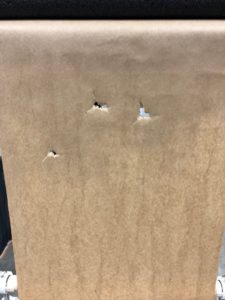Bowtech’s 2017 flagships, the Reign 6 and Reign 7, won a litany of awards in 2017. Though I never fired the Reign 6, I was a big fan of the Reign 7. The bow drew with ease, was stable at full draw and was very accurate. I used the bow on a number of spring and fall outings and was very satisfied with its performance. When the 2018 bow chatter started a few months back, I was eager to see what Bowtech had up its sleeve for 2018.
Though the Realm is undeniably Bowtech, the rig does boast a pile of new features that set it apart in both looks and overall specs. The less-reflexed, caged-top-and-bottom riser looks beefy, and although I do prefer a direct hand-to-riser grip, I found the Clutch Performance Grip to be comfortable. Also new, and something I really applaud, is the attention Bowtech placed on limb design. If there was one area of performance Bowtech lagged in, it was limb-and-pocket function. The new CP Dual Lock Pocket ushers Bowtech into a new arena of limb design and overall function. The limbs are wide and look solid, and the Dual Lock Pocket locks the limbs to the pocket and the pocket to riser. More on this later.
I also noticed the addition of the Orbit Dampener, which comes affixed near the bottom of the riser. It’s on the opposite side of where the quiver or sight would be attached and it’s threaded, allowing shooters to stack weights for appropriate balance.
During my initial inspection, I noticed zero machining marks. The bow is clean, sleek and sexy.
The set screws (which needed to be loosened to adjust draw weight) and limb bolts turned easily and with no chatter, and the bow pressed perfectly. The bow, out of the box, had the Flip Disc set to the Comfort setting. I’m not a speed demon, so I opted to leave the bow in the Comfort setting, but adjustment to the Performance setting is easy. The set screws and washers are small, so I recommend working on the bow in a lighted area and using a small pan or cup to hold screws and washers.
Tuning was a breeze. I simply used the OverDrive Binary Cam system and the split yokes to walk my arrow to achieve a perfect paper tear. This cam system makes tuning a breeze, and if you’ve never utilized it to achieve a perfect paper tear, you need to. Perfect paper-tear tuning took three shots and about eight minutes to accomplish.
My test bow came at a peak draw weight of 60 pounds, and the draw cycle, in the Comfort setting, was exceptionally smooth. The dual draw-stop pegs contact the bow’s inner cable, and transition to letoff is not at all abrupt. At full draw the bow holds very steady; I credit this to the design of the riser and the new limb-and-pocket design, which allows the full length of the limb to bend at full draw and return all the way to brace. The center-pivot design moves the pivot point to the center of the limb and, as previously mentioned, is totally locked down.
At the shot the bow is quiet and reasonably dead in the hand. The CP Dual Lock system again plays a big role in this, but so does the string stop and new Orbit Dampener.
Set at 60 pounds and a draw length of 28.5 inches, the test bow, with a 450-grain FMJ arrow, produced a three-arrow average speed rating of 266 fps.
Downrange accuracy was exceptional. I credit this to the OverDrive Binary Cams, CP Dual Lock system and, of course, the FLX Guard, which allows the arrow to travel through the bow without contacting the cables. The FLX Guard allows the shooter to reach full draw and lets the cables flex back into their natural positon. This basically eliminates torque.
I shot field points, mechanicals and fixed-blade heads out to 100 yards with incredible results. I really appreciate the fact that this Smartbow allows the shooter to maximize personal accuracy by offering a number of customizable options.
The Realm measures 30 ¾ inches axle to axle, has a 7 1/8-inch brace height, and is offered in peak draw weights of 50, 60 and 70 pounds. Mass weight without accessories is 4.3 pounds, and the bow is draw-length adjustable between 25 and 31 inches by shifting the module in half-inch increments.







